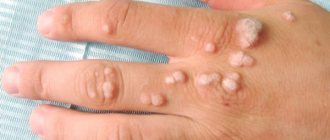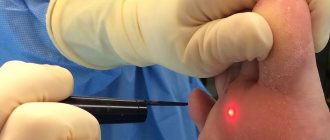In this article we will tell you what papillomavirus is and how it is dangerous. Do papillomas need to be removed? And also about the features of the laser removal method and contraindications to its implementation.
Papillomas are benign formations on the skin and mucous membranes caused by the human papillomavirus (HPV). In their appearance, the formations resemble a pedunculated papilla (rapula) - translated as a nodule. This type of formation occurs most often and its distinctive feature is the ability to appear on any part of the body: face, neck, foot, head, chest, back, genital area and even mucous clouds. Such growths are most often flesh-colored or cinnamon in color. The formations can be either single or multiple; they can connect with each other and create growths that occupy large areas of the body.
Causes of papillomas
According to statistics, more than 90% of the population are carriers of HPV, but it does not affect everyone. This is due to the state of the immune system. The lower the immunity, the higher the likelihood of papillomas. If you have growths characteristic of papillomavirus, this indicates a decrease in immunity.
You can become infected with HPV in different ways:
- Physically, even with a handshake
- Sexually
- When using common household and hygiene items
- When visiting baths, saunas, nail salons
- Perinatal route - infection can pass from mother to child.
There are many varieties of papillomavirus, conditionally they are divided into 3 groups according to risk level:
- Short
- Average
- High
Low-level papillomas can disappear on their own over a period of 6 months to 2 years, while high-risk ones can degenerate into cancerous formations. There is a high risk of degeneration into a malignant formation in papillomas located on the genitals. In women, HPV can cause uterine cancer, the inability to conceive a child, the cause of infertility, failure to carry a pregnancy to term, and postpartum complications.
Types of laser hair removal
The type of laser hair removal depends on the type of lasers used for it. Today there are four of them.
- Ruby laser (used extremely rarely, as it is obsolete) with a wavelength of 694 nm, which destroys the hair pigment and does not have a detrimental effect on its follicle.
- Alexandrite laser (popular) with a wavelength of 755 nm, which effectively removes hair of any color growing on skin of phototypes I – IV.
- Diode laser (popular) with a wavelength of 808 - 810 nm, which is capable of removing dark and dark brown hair on skin of phototype I - VI.
- Neodymium laser (due to its “aggressive” effect is used in exceptional cases) with a wavelength of 1064 – 1320 nm, which affects the hair pigment and causes coagulation (sealing) of the vessels feeding its follicle.
Knowing the wavelength of light is necessary to estimate its absorption coefficient. Long-wave exposure easily reaches the follicle. On the one hand, this is good, but on the other, it means that its energy can be absorbed by competing skin chromophores (melanin and water contained in the tissue), which leads to a decrease in the effectiveness of hair removal. While short-wave radiation does not reach the follicle, it is poorly absorbed by skin chromophores, but it specifically affects the pigment of the hair shaft.
If we compare procedures on popular devices with each other, then hair removal with an alexandrite laser is considered more delicate. While the use of a diode laser allows you to treat darker skin of the face and body.
The benefits and harms of laser hair removal
The use of laser technology guarantees long-term results that can be successfully maintained throughout life.
Among the obvious advantages of the procedure, the following relevant points can be noted:
- non-invasive - without damaging the integrity of the skin;
- non-contact – only the laser beam affects the skin;
- painlessness - the use of cooling and local anesthesia eliminates discomfort;
- sterility – laser light energy demonstrates a bactericidal effect;
- versatility - the procedure is suitable for women and men with any skin type and hair color;
- high efficiency – all unwanted hair in the active growth stage is removed.
At the same time, directly opposite information about the uselessness and danger of procedures is actively discussed on popular forums and social networks. Its implementation is surrounded by myths reminiscent of “horror stories” about the dangers of laser hair removal for the body: they say it leads to the development of candidiasis (thrush), cancer and increased hair growth. It’s easy to refute these myths - it’s enough to have basic knowledge in the field of medicine and human physiology.
Laser light energy has a pronounced bactericidal effect. Its effect inactivates (destroys) pathogenic microorganisms, including fungi of the genus Candida, the active reproduction of which leads to the development of candidiasis.
Therefore, there are no negative consequences of laser hair removal in the bikini area. In this case, the exact opposite effect is observed: an absolutely clean field of “norm” - a complete absence of fungal infection, which is confirmed by the polymerase chain reaction method.
Laser light energy does not provoke uncontrolled proliferation (reproduction) of cells, characteristic of oncogenesis. Its exposure does not lead to the development of cancer! Moreover, recently lasers have been actively used in the treatment of cervical cancer, after chemotherapy and radiation therapy.
Laser light energy does not enhance hair growth. After all, this process is controlled by hormones that are produced in the endocrine glands of the body. During treatment of problem areas, the laser has no effect on them.
It is difficult to say on what basis such ridiculous myths are born, forcing girls to wonder whether laser hair removal is harmful to health. Answering this question, we can say with complete confidence that in the absence of contraindications and the procedure is carried out correctly, it does not cause any harm to the body.
Do papillomas need to be removed?
Changes in color and size are one of the possible signs of the onset of malignant processes in the body. Experts recommend contacting a medical facility if the papilloma is bleeding, it is inflamed and bothers you, it is a cosmetic defect, and also if there are signs of its degeneration. If papillomas are not removed in time, then the risk of its growth and degeneration is very high. Formations detected in the early stages, including malignant ones, are almost always curable.
How to prepare for the procedure
No special preparation is required for the procedure. Usually papillomas are removed on an outpatient basis in one day. The patient must be responsible when choosing a medical or beauty salon that provides this service and make sure that they have the necessary certificates and licenses.
Experts recommend that 10-14 days before the scheduled session to remove papillomas, avoid visiting the solarium and use sunscreen when walking in the fresh air. In addition, during the preparatory period it is recommended to avoid contact with household chemicals. If the growths are located on the face or neck, it is advisable to avoid using decorative cosmetics.
Laser removal of papillomas: features of the method
There are several ways to remove papillomas:
- Surgical removal
- Cryotherapy – exposure to low-temperature nitrogen
- Electrocoagulation
- Use of chemical reagents.
All these methods are of course practiced in modern medicine, but these procedures are painful and require a long period of rehabilitation.
Today, modern medicine offers an effective and painful method for removing papillomas and other formations using laser surgery. Laser removal is the most optimal method, which is used by doctors around the world, allowing you to get rid of problems in a short time without the risk of relapse.
Technique
Cauterization of one papilloma takes 1-3 minutes depending on the size. Before the session, the doctor examines the tumor and determines the optimal laser power. The procedure goes as follows:
- The patient wears dark glasses with light filters to protect the eyes from accidental radiation.
- The skin is treated with an antiseptic and an anesthetic ointment is applied for 15 minutes.
- The doctor points the laser tip at the tumor and evaporates it layer by layer.
- After therapy, the treated area of skin is again disinfected and an adhesive plaster is applied.
A small papilloma is removed in one session. If the growths are large and located throughout the body, several procedures will be required. Laser removal of tumors in children is carried out according to a similar protocol.
How does laser removal work?
A distinctive feature of this method is the targeted effect on the papilloma itself, while healthy areas of the skin are not affected. The formation is evaporated layer by layer. The laser is capable of treating tissue areas of any depth, while this method is bloodless, the laser seals the capillaries and the blood instantly stops. Most often, just one procedure is enough to completely get rid of the problem and get an excellent cosmetic effect.
A huge advantage is that it can be used on any part of the body and even on the mucous membranes. The doctor independently regulates the frequency of pulses and the dosage of laser radiation - this avoids overheating and eliminates the risk of burns during the procedure. After the procedure, a crust appears at the site of laser exposure, which cannot be removed independently. It will remove itself in about a week, and healthy skin will form in its place.
Possible complications
Complications rarely occur after laser therapy. If the doctor sets excessive power and incorrectly calculates the time of exposure, the damaged area may swell and hurt. The wound begins to fester when infected due to poor hygiene during rehabilitation. Also, a consequence of the removal of large growths is the formation of keloid scars.
After the laser, papillomas may appear again in even greater numbers. This complication occurs due to the intensive phase of the virus, when cauterization of the growth without additional therapy is ineffective.
Pink spots remain at the site of the removed papilloma. They will fade after 4-5 days and completely disappear in a few months.
What is needed to undergo treatment?
Today, there are several ways to remove papillomas and other formations on the skin and mucous membranes, but the laser method is superior to all these methods in terms of efficiency. The specialists of Dr. Novikov’s center have been successfully working in the field of laser medicine and cosmetology for many years. The procedure for removing papillomas in Moscow in our center is carried out on an outpatient basis. We remove papillomas in both men and women on any part of the body as effectively as possible. You can make an appointment with our specialists by calling +7, or use the convenient feedback form.
Rehabilitation after the procedure
Best materials of the month
- Coronaviruses: SARS-CoV-2 (COVID-19)
- Antibiotics for the prevention and treatment of COVID-19: how effective are they?
- The most common "office" diseases
- Does vodka kill coronavirus?
- How to stay alive on our roads?
The period of complete healing of a papilloma wound takes from 7 to 14 days. At this time, the patient may notice the appearance of swelling or redness, which quickly disappears without the use of additional therapy. It is forbidden to rip off or lubricate with any substance the dense crust that has formed on top of the wound - it will fall off on its own.
Complete healing of the skin is observed after 28-30 days - at this point the trace of the procedure becomes completely invisible. Before this period, it is not recommended to visit the pool or sauna, and you should also avoid sunbathing.
Prevention of papillomavirus
Doctors at Dr. Novikov’s clinic take a comprehensive approach to the treatment of papillomas, therefore, after removal, in order to avoid the reappearance of formations, they recommend undergoing antiviral and immunostimulating therapy.
In order to avoid relapse, as well as to prevent infection, carriers of this virus are recommended to:
- Get tested periodically for the presence of HPV in your blood.
- Control the growth of existing formations
- Have only protected sex
- Use only your own hygiene products
- Eat properly
- Strengthen the immune system
- When visiting saunas and baths, use your own replacement shoes
Is epilation of armpits and bikini area harmful?
When answering the question whether a deep bikini is harmful or not, it is worth remembering the non-invasive, non-contact and sterile nature of the method.
Its implementation does not harm the external and internal genital organs of a woman. Confirmation of this is the active use of lasers for vulvovaginal rejuvenation, which eliminates age-related atrophy, muscle relaxation, stress urinary incontinence and prolapse (protrusion) of the genitals. Laser hair removal also does not cause any harm to the armpits. Author: Khazova Alla Sergeevna
Contraindications for laser papillomas removal
The procedure for removing papillomas with a laser is safe, but there are still reasons when you need to refrain from this method of removal. Now we will look at them:
- Oncology or suspected cancer
- Pregnancy and breastfeeding period
- Diabetes
- Herpes during an exacerbation
- Acute viral infections
- Endocrine system diseases
- Epilepsy
- Exacerbation of chronic diseases
Important! Health issues should be dealt with by professionals. If you have papillomas and you notice signs of their formation or they cause discomfort. The only correct solution to the problem is to contact specialists at a medical institution.
In no case should you remove the formation on your own, as you can aggravate the condition and delay the healing process. Timely elimination of papillomas and other skin problems will avoid the development of serious pathologies. At Dr. Novikov's laser medicine center you can undergo a consultation and receive qualified medical care. Experienced specialists will help you quickly and painlessly get rid of papillomas and other formations.
Why PRESIDENTMED?
- This is the leading medical institution in the Russian Federation, using only certified and safe treatment methods!
- This is a center of excellence for training specialists in hardware methods!
- These are highly qualified specialists, professors, candidates of science, world-famous doctors!
- this is the introduction of new methods of diagnosis, treatment and the use of “last word” technologies in medicine!
Our clinic employs only experienced specialists who are constantly trained in the latest methods of hardware cosmetology. The clinic is also the largest specialist training center in the Russian Federation.
Removal of papillomas using a laser at the PRESIDENTMED clinic will give you aesthetic comfort and youth for a long time.
Why do vaginal papillomas occur?
The main cause of papilloma in the vagina is the papilloma virus. It enters the body through unprotected sexual contact with a carrier. However, there are a number of factors that increase the likelihood of infection. These include sexually transmitted diseases (for example, gonorrhea and chlamydia).
Also, the reasons that contribute to the development of papillomas are:
- frequent change of sexual partners;
- disruption of the normal vaginal microflora (dysbiosis);
- low immunity;
- inflammation of the ovaries;
- severe stressful situations;
- pregnancy;
- deviations from the endocrine system;
- lack of vitamins in the body.
If several of the reasons described above are present, the risk of infection increases significantly. The incubation period is no more than 3 months, but under the influence of unfavorable circumstances for the immune system, this time can be reduced to 14-20 days.











